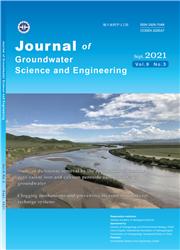Application of GIS based analytical hierarchy process and multicriteria decision analysis methods to identify groundwater potential zones in Jedeb Watershed, Ethiopia
IF 1.8
4区 地球科学
Q3 WATER RESOURCES
引用次数: 0
Abstract
The hydrogeological situation of the study area requires the identification of groundwater potential. Remote sensing and satellite data have proven to be reliable tools for understanding various factors that affect groundwater occurrence and movement. This study employed weighted overlay analysis based on satellite imagery and secondary data to create a thematic map for characterizing groundwater potentials in the study area located within Abbay Basin, Ethiopia. Remote sensing (RS) and GIS-based Fuzzy-Analytical Hierarchy Process methods were utilized to classify groundwater potential (GWP) zones into five categories: Very good, good, moderate, poor, and very poor. The central and eastern parts of the study area were identified as having high (33.186%) and very high (2.351%) groundwater potentials, while the western part exhibited poor and very poor potential areas. The groundwater potential map delineated higher and moderate potentials, suitable for installing shallow and production bores. This research demonstrates the effectiveness of RS and GIS techniques for delineating groundwater potential zones, which can aid in the planning and management of groundwater resources. The research findings have the potential to contribute to the formulation of improved groundwater management programs in the study area.基于GIS的层次分析法和多准则决策分析方法在埃塞俄比亚Jedeb流域地下水潜力带识别中的应用
研究区水文地质状况要求对地下水潜力进行识别。遥感和卫星数据已被证明是了解影响地下水发生和移动的各种因素的可靠工具。本研究采用基于卫星图像和二次数据的加权叠加分析,创建了一个专题地图,用于表征位于埃塞俄比亚Abbay盆地的研究区域的地下水潜力。利用遥感(RS)和基于gis的模糊层次分析法(Fuzzy-Analytical Hierarchy Process)将地下水潜势区(GWP)划分为极好、良好、中等、较差和极差5类。研究区中部和东部为地下水潜力高区(33.186%)和极高区(2.351%),西部为地下水潜力差区和极差区。地下水位势图圈定了中高位势,适合安装浅层井和生产井。本研究证明了RS和GIS技术在划定地下水潜力带方面的有效性,有助于地下水资源的规划和管理。研究结果有可能为研究区地下水管理方案的制定做出贡献。
本文章由计算机程序翻译,如有差异,请以英文原文为准。
求助全文
约1分钟内获得全文
求助全文
来源期刊

Journal of Groundwater Science and Engineering
WATER RESOURCES-
CiteScore
2.80
自引率
9.10%
发文量
308
期刊介绍:
It publishes original, innovative, and integrative research in groundwater science and engineering with a focus on hydrogeology, environmental geology, groundwater resources, agriculture and groundwater, groundwater resources and ecology, groundwater and geologic environment, groundwater circulation, groundwater pollution, groundwater exploitation and utilization, hydrogeological standards and methods, groundwater information science, climate change and groundwater. The Editorial Board is composed of more than sixty world-renowned experts and scholars, 47% of whom are foreign scientists. Up to now, the foreign authors contributed papers are from USA, Japan, Canada, Australia, Russia, Mongolia, Thailand and Vietnam.
 求助内容:
求助内容: 应助结果提醒方式:
应助结果提醒方式:


